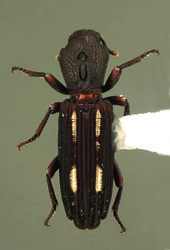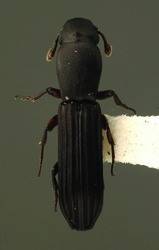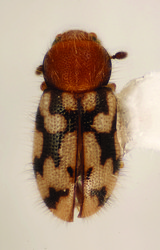Bothrideridae
Cocoon-forming beetles
Nathan P. Lord- Bothriderinae Erichson, 1845
- Teredinae Seidlitz, 1888
- Xylariophilinae Pal and Lawrence, 1986
- Anommatinae Ganglbauer, 1899
Introduction
Bothrideridae is an extremely diverse group of small, lesser-known beetles. The family currently contains about 38 genera and 400 species divided into four subfamilies (Anommatinae, Bothriderinae, Teredinae, and Xylariophilinae). Bothriderids are found in all major zoogeographical regions of the world with the majority of diversity in the Old World tropics.
Characteristics
Morphology, adults: The family Bothrideridae exhibits great diversity in body form and appearance, often making identification difficult. The best characters to define adults are: small size (1.4-12.0 mm), elongate to elongate-oval shape, 4-4-4 tarsi (3-3-3 in Anommatinae), capitate antennae with 9-11 segments, antennal club usually compact, consisting of 1-3 segments, antennal insertions exposed, cucujoid-form aedeagus, heteromeroid trochanters (except in Teredinae), five free abdominal ventrites, and a body length greater than 2.75 times the greatest body width. There is no single character that unites all members of the family.
Morphology, free-living larvae: body elongate, parallel-sided, slightly flattened. Dorsal surfaces granulate, aspirate, and tuberculate; vestiture with simple, scale-like setae. Head prognathous, posterior edge arcuate. Epicranial stem short to absent; frontal arms lyriform; endocarinae absent. Stemmata absent (Anommatus) or six on each side. Frontoclypeal suture weak or absent. Labrum free. Antenna 3-segmented, separated from mandibular articulation by a narrow strip of cuticle. Mandibles symmetrical, tridentate, with well-developed mola. Hypopharyngeal sclerome present. Hypostomal rods moderately long and diverging posteriorly. Gular sutures separate, gula wider than long. Legs well-developed, 5-segmented, pretarsus with one seta. Abdomen less than twice as long as thorax (adapted from Ślipiński et al., in press).
Morphology, ectoparasitic larvae: body elongate, cylindrical, abdomen may be physogastric, lightly sclerotized, surface with short setae. Head protracted, distinctly narrower than prothorax, epicranial stem absent, stemmata absent. Antenna 1- or 2-segmented, separated from mandibular articulation by broad strip of cuticle, sensorium long, inserted on segment 1. Frontoclypeal suture absent. Mandibles symmetrical, unidentate or bidentate, lacking mola. Hypopharyngeal sclerome absent. Hypostomal rods absent. Gular sutures indistincy, gula longer than wide. Legs reduced in most (well-developed, 5-segmented in Deretaphrus). Abdomen more than twice as long as thorax (adapted from Ślipiński et al., in press).
Morphology, triungulin stage of ectoparasitic larvae: body elongate, fusiform, moderately to strongly flattened, more heavily sclerotized than free-living larvae. Head with one or two well-developed stemmata on each side. Antenna 2-segmented with antennomere 1 very short and antennomere 2 elongate with long terminal seta. Mandibles narrow and sickle-shaped, lacking mola and prostheca. Labrum and clypeus fused to head capsule. Ventral mouthparts protracted. Labial palps 2-segmented and very close to each other. Thoracic segments with long, 5-segmented legs, trochanter with long seta, pretarsus simple (adapted from Ślipiński et al., in press).
Biology
All Bothrideridae (except for Anommatinae) are found under the bark of dead or dying trees or in the surrounding litter and are commonly associated with wood-boring insects. Many are cylindrical in shape and exhibit morphological adaptations for occupying the tunnels and galleries of wood-boring beetles
Within the family, two or three distinct biological groups exist. Larvae of the subfamily Bothriderinae are hypermetamorphic and suspected to be ectoparasitic on the larvae and pupae of wood-boring insects. First instar bothriderine larvae are triungulins that actively seek out a suitable host. Upon finding a host, the triungulin develops into a grub-like larva that attaches to the host to feed. Prior to pupation, larvae spin individual silken cocoons or casings in which they pupate. The “cocoons” may be attached to the old host, or the larvae may migrate a short distance away within the gallery to pupate.
Adults of the Bothriderinae have been documented feeding on members of the coleopteran families Cerambycidae, Anobiidae, Bostrichidae, Curculionidae, Brentidae, Buprestidae, and Mycteridae, as well as members of the hymenopteran families Apidae (Xylocopa sp.) and Xiphydriidae (Xiphydria sp.) (Balduf, 1935; Clausen, 1940; Lieu, 1944; Pollock and Ivie, 2004; Ślipiński et al. in press). Several genera (Bothrideres, Deretaphrus, Sosylus) are frequently encountered in the bored tunnels of platypodine and scolytine weevils. Members of the genus Sosylus in particular are specialists on platypodines and scolytines, either as generalists or as species-specific predators (Browne, 1962; Roberts, 1969, 1980). The western North American Deretaphrus oregonensis was given the nickname “The Buprestid Destroyer” by Essig (1926), who stated that the adult “lives in the burrows and destroys the larvae and pupae…” of a number of wood-boring beetles in California and Oregon. Members of Bothriderinae may be critically important to the control of destructive, wood-boring insects, but much of the natural history of bothriderids remains unexplored
Larvae of Teredinae and Xylariophilinae are thought to be mycophagous. Xylariophiline larvae feed on ascomycete fungi, and larvae of Teredinae feed on fungus in the galleries of ambrosia beetles. Larvae of these groups do not have a triungulin stage and have not been observed to construct cocoons for pupation.
Adults of Anommatinae are apterous and anophthalmus and are found in rich, organic soil (compost, grass cuttings). Anommatines are rarely encountered but can sometimes be taken in large numbers. It is speculated members of the genus Anommatus can reproduce parthenogenetically (Crowson, 1981). Little else is known about the biology of this enigmatic subfamily.
In general, bothriderids are most commonly collected at lights at night, but a good number can be found peeling the bark of dead or dying trees. Members of the genus Sosylus can be captured running on felled logs or trees recently infested with platypodine or scolytine weevils. Teredine bothriderids can be collected by inspecting or fogging wood occupied by ambrosia beetles.
Taxonomy
The composition and classification of the family has undergone considerable change since the early 1900s. Historically, most members of the group were placed as distinct subfamilies or tribes within the Colydiidae (Ivie and Ślipiński, 1990), often associated with the tribes Cerylini or Cerylonini (now Cerylonidae). The subfamily Anommatinae once resided in the family Latridiidae on account of their trimerous tarsi, but was later transferred to a redefined subfamily within the Colydiidae consisting of the present-day bothriderid and cerylonid groups. Despite suggestions by Craighead (1920), previous workers continued to treat Bothrideridae as a colydiine subfamily until Lawrence (1985) elevated the group to family status, and demonstrated that bothriderids belonged not to Tenebrionoidea, but Cucujoidea.
There have been few comprehensive familial or generic-level treatments of the group. Hetschko’s catalogue of Colydiidae in the Coleoptorum Catalogus (1930) was the last thorough checklist published. While Ślipiński et al. (1989) published a very useful review of the subfamily Bothriderinae, no recent works have treated the full diversity of the family. The publication of numerous isolated species descriptions and regional treatments (e.g., Carter and Zeck, 1937; Dajoz, 1969, 1980; Horn, 1878; Heinze, 1943; Nikitsky, 1985; Pope, 1952, 1954, 1955, 1961, 1980; Sharp, 1894; Stephan, 1989) has only perpetuated confusion at the specific and generic levels. There are a number of suspected synonyms as well as undescribed taxa within the Bothrideridae, and the generic definitions remain far from resolved. It is very likely the diversity of the group is much greater than currently known, and there persists a great need for continued taxonomic work within the family.
Discussion of Phylogenetic Relationships
Except for recent large-scale molecular phylogenetic studies by Hunt et al. (2007) and Robertson et al. (2008), no rigorous phylogenetic analysis of Bothrideridae has been performed. Hunt et al. (2007) recovered a paraphyletic Bothrideridae, but the taxon sampling did not include the distinct Bothriderinae. Robertson et al. (2008) recovered a monophyletic Bothrideridae, but only included one subfamily. Both studies suggest a close relationship between Bothrideridae and Cerylonidae but lacked adequate taxon sampling for family-level conclusions. Morphological characters reveal little difference from free-living Bothrideridae (Teredinae, Xylariophilinae, Anommatinae) and members of Cerylonidae. This relationship needs further examination.
Other Names for Bothrideridae
- Anommatidae
- Vernacular Names: Cocoon-forming beetles, Dry bark beetles, Bothriderid beetles
References
Balduf, W.V. 1935. The Bionomics of Entomophagous Coleoptera. E.W. Classey Ldt., Hampton.
Browne, F.G. (1962). Sosylus spectabilis Grouvelle (Coleoptera, Colydiidae), a predator and parasite of African ambrosia beetles. 5th Rep. W. Afr. Timber Borer Res. Unit. : 91-96.
Burke, H.E. 1919. Notes on a Cocoon Making Colydiid (Coleopt.). Proceedings of the Entomological Society of Washington 21: 123-124.
Carter, H.J., and E.H. Zeck. 1937. A Monograph of the Australian Colydiidae. The Proceedings of the Linnean Society of New South Wales 62: 181-208 + pl. VIII-IX.
Clausen, C.P. 1940. Entomophagous Insects. McGraw-Hill Book Company, New York. 688 pp.
Craighead, F.C. 1920. Biology of Some Coleoptera of the Families Colydiidae and Bothrideridae. Proceedings of the Entomological Society of Washington 22: 1-13.
Craighead, F.C. 1950. Insect Enemies of Eastern Forests. U.S. Department of Agriculture Miscellaneous Publication No. 657. United States Government Printing Office, Washington. 679 pp.
Crowson, R.A. 1955. The Natural Classification of the Families of Coleoptera. Nathaniel Lloyd, London (seen as 1967 reprint, E.W. Classey Ldt., Hampton. 214 pp.)
Crowson, R.A. 1981. The Biology of the Coleoptera. Academic Press, London. 802 pgs.
Dajoz, R. 1969. Révision des Colydiidae anophthalmes de la faune paléarctique. II. - Notes complémentaires sur les genres Anommatus et Abromus. Revue d'Ecologie et de Biologie du Sol 3: 377-389.
Dajoz, R. 1980. 54. Insectes Coléoptères: Colydiidae et Cerylonidae, pp. 256, Faune de Madagascar. CNRS, Paris.
Erichson, W.F. 1845. Naturgeschichte der Insecten Deutschlands. Erste Abtheilung, Coleoptera, Vol. 3, pp. 1-320. Verlag der Nicolaischen Buchhandlung, Berlin.
Heinze, E. 1943. Studien zur Kenntnis der Tribus Deretaphrini und deren Stellung im System (Colydiidae). Entomologische Blätter für Biologie und Systematik der Käfer 39: 85-93, 97-124.
Hetschko, A. 1930. Colydiidae. In: W. Junk, S. Schenkling [eds.], Coleopterorum Catalogus. Berlin. Pars 107, 124 pp.
Horn, G.H. 1873. Descriptions of some new North American Coleoptera. Transactions of the American Entomological Society 4: 143-152.
Horn, G.H. 1878. Synopsis of the Colydiidae of the United States. Proceedings of the American Philosophical Society 17: 555-592.
Hunt, T., J. Bergsten, Z. Levkanicova, A. Papadopoulou, O. St. John, R. Wild, P.M. Hammond, D. Ahrens, M. Balke, M.S. Caterino, J. Gomez-Zurita, I. Ribera, T.G. Barraclough, M. Bocakova, L. Bocak, and A.P. Vogler. 2007. A comprehensive phylogeny of beetles reveals the evolutionary origins of a superradiation. Science 318: 1913-1916.
Ivie, M.A., and A. Ślipiński. 1990. Catalog of the genera of world Colydiidae (Coleoptera). Annales Zoologici 43: 1-32.
Lawrence, J.F. 1980. A new genus of Indo-Australian Gempylodini with notes on the constitution of the Colydiidae (Coleoptera). Journal of the Australian Entomological Society 19: 293-310.
Lawrence, J.F. 1991. Bothrideridae (Cucujoidea) pp. 477-479. In: Stehr, F.W. (Ed.). Immature Insects, Vol. 2. Kendall/Hunt Publishing Company, Dubuque, Iowa.
Lieu, V. 1944. A preliminary note on the colydiid parasite of a willow-branch-cerambycid. Indian Journal of Entomology 6: 125-128.
Nikitsky, N.B. 1985. The cylindrical bark beetles (Col., Colydiidae) and Cerylonidae of the Soviet Far East. Sbornik trudov Zoologicheskogo 23: 3-37.
Pal, T.K., and J.F. Lawrence. 1986. A new genus and subfamily of mycophagous Bothrideridae (Coleoptera; Cucujoidea) from the Indo-Australian region, with notes on other related families. Journal of the Australian Entomological Society 25: 185-210.
Philips, T.K., and M.A. Ivie. 2002. 90. Bothrideridae Erichson 1845, pp. 358-362. In: R.H. Arnett, M.C. Thomas, P.E. Skelley and J.H. Frank [eds.], American Beetles, vol. 2: Polyphaga: Scarabaeoidea through Curculionoidea. CRC Press LLC, Boca Raton.
Pollock, D.A., and M.A. Ivie. 2004. Description of the larva of Phaeogala rufa Abdullah (Coleoptera: Mycteridae: Lacconotinae), with nomenclatural notes for the genus Phaeogala. Proceedings of the Entomological Society of Washington 106 (3): 697-704.
Pope, R.D. 1952. New species of Colydiidae from the Belgian Congo and Notes on Others. Annales du Musée Royal du Congo Belge Tervuren (Belgique) (8) 19: 45 pp.
Pope, R.D. 1954. On a Collection of Colydiidae (Coleoptera) from Angola. Publicacoes Culturais da Companhia de Diamantes de Angola 23: 109-118.
Pope, R.D. 1955. On a Collection of Colydiidae from Belgian Congo (Col.). Revue de Zoologie et de Botanique Africaines 50: 243-260.
Pope, R.D. 1961. Colydiidae (Coleoptera Clavicornia). Exploration du Parc National de la Garamba, Fascicule 25:116 pp.
Pope, R.D. 1980. A revision of the species of Sosylus (Coleoptera: Colydiidae) occurring in New Guinea. Bulletin of Entomological Research 70: 235-244.
Roberts, H. 1969. A note on the Nigerian species of the genus Sosylus Erichson (Col. Colydiidae), parasites and predators of ambrosia beetles. Journal of Natural History 3: 85-91.
Roberts, H. 1980. Description of the developmental stages of Sosylus spp. (Coleoptera: Colydiidae) from New Guinea, parasites and predators of ambrosia beetles (Coleoptera: Platypodidae). Bulletin of Entomological Research 70: 245-252.
Robertson, J.A., M.F. Whiting and J.V. McHugh. 2008. Searching for natural lineages within the Cerylonid Series (Coleoptera: Cucujoidea). Molecular Phylogenetics and Evolution 46 (1): 193-205.
Ślipiński, A., R.D. Pope, and R. Aldridge. 1989. A review of the world Bothriderini (Coleoptera, Bothrideridae). Polskie Pismo Entomologiczne 59: 131-202.
Ślipiński, A.S., N.P. Lord and J.F. Lawrence. 10.28. Bothrideridae Erichson, 1845. In: R.A.B. Leschen and R.G. Beutel, eds., Handbook of Zoology – Coleoptera, vol. II. De Gruyter, Berlin, New York. In Press.
Stephan, K.H. 1989. The Bothrideridae and Colydiidae of America north of Mexico (Coleoptera: Clavicornia and Heteromera). Occasional Papers of the Florida State Collection of Arthropods 6: 1-65.
Title Illustrations

| Scientific Name | Ascetoderes signatus |
|---|---|
| Specimen Condition | Dead Specimen |
| Identified By | S.A. Ślipiński |
| Life Cycle Stage | Adult |
| Copyright |
© 2009 Nathan P. Lord

|
| Scientific Name | Anommatus duodecimstriatus |
|---|---|
| Specimen Condition | Dead Specimen |
| Identified By | N.P. Lord |
| Life Cycle Stage | Adult |
| Copyright |
© 2009 Nathan P. Lord

|
| Scientific Name | Sosylus sp. |
|---|---|
| Location | Bolivia |
| Specimen Condition | Dead Specimen |
| Identified By | N.P. Lord |
| Life Cycle Stage | Adult |
| Copyright |
© 2009 Nathan P. Lord

|
| Scientific Name | Xylariophilus bicoloripennis |
|---|---|
| Specimen Condition | Dead Specimen |
| Identified By | S.A. Ślipiński |
| Life Cycle Stage | Adult |
| Type | Paratype |
| Copyright |
© 2009 Nathan P. Lord

|
About This Page
Special thanks to Joseph V. McHugh and Kelly B. Miller for providing useful comments and suggestions. Adam Ślipiński is gratefully acknowledged for continuous help and support pertaining to the family Bothrideridae. Thanks are also given to all members of the McHugh and Miller labs. Partial support for the construction of this page was provided by the H.H. Ross Endowment of the Department of Entomology at the University of Georgia, through an NSF AToL grant EF-0531665 to M.F. Whiting (subcontract to J.V. McHugh) and through an NSF PEET grant (DEB-0329115) to J.V. McHugh, M.F. Whiting, and K.B. Miller.
Nathan P. Lord

University of New Mexico, Albuquerque, New Mexico, USA
Correspondence regarding this page should be directed to Nathan P. Lord at
Page copyright © 2011 Nathan P. Lord
All Rights Reserved.
- First online 22 September 2009
- Content changed 22 September 2009
Citing this page:
Lord, Nathan P. 2009. Bothrideridae. Cocoon-forming beetles. Version 22 September 2009. http://tolweb.org/Bothrideridae/9165/2009.09.22 in The Tree of Life Web Project, http://tolweb.org/















 Go to quick links
Go to quick search
Go to navigation for this section of the ToL site
Go to detailed links for the ToL site
Go to quick links
Go to quick search
Go to navigation for this section of the ToL site
Go to detailed links for the ToL site